Retinal complications associated with congenital optic disc anomalies determined by swept source optical coherence tomography
- PMID: 29018703
- PMCID: PMC5602127
- DOI: 10.1016/j.tjo.2015.05.003
Retinal complications associated with congenital optic disc anomalies determined by swept source optical coherence tomography
Abstract
Optical coherence tomography has evolved over the past 2 decades to be an important ancillary method to evaluate diseases of the anterior and posterior segments of the eye. The more recent development of swept-source optical coherence tomography (SS-OCT) with a wavelength-tunable laser centered at 1050 nm and deeper imaging depth of 2.6 mm has enabled clinicians to evaluate congenital optic disc anomalies including optic disc pits, optic disc colobomas, and morning glory syndrome in more detail. The SS-OCT findings of the posterior precortical vitreous pocket, Cloquet's canal, lamina cribrosa that is torn from the peripapillary sclera, and the retrobulbar subarachnoid space immediately posterior to the highly reflective tissue lining the bottom of the excavation are presented. In addition, abnormal communications between the vitreous cavity and the subretinal and subarachnoid spaces in eyes with congenital optic disc anomalies are also reviewed. The retinal complications associated with congenital optic disc anomalies are treated by vitreous surgery, silicone oil tamponade, and peripapillary laser photocoagulation or scleral buckling. However, the surgical outcomes are limited and not entirely satisfactory. Analyses by SS-OCT of congenital optic disc anomalies should make the treatment correspond better with the pathological findings.
Keywords: coloboma; congenital optic disc anomaly; morning glory syndrome; optic disc pit; optical coherence tomography.
Conflict of interest statement
Conflict of interest: The author has no conflict of interest concerning in this study
Figures
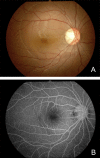

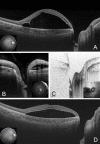

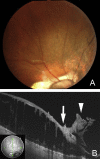
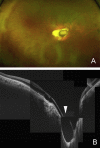
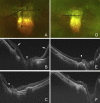
Similar articles
-
Evaluation of congenital optic disc pits and optic disc colobomas by swept-source optical coherence tomography.Invest Ophthalmol Vis Sci. 2013 Nov 25;54(12):7769-78. doi: 10.1167/iovs.13-12901. Invest Ophthalmol Vis Sci. 2013. PMID: 24168988
-
Evaluation of congenital excavated optic disc anomalies with spectral-domain and swept-source optical coherence tomography.Graefes Arch Clin Exp Ophthalmol. 2014 Nov;252(11):1853-60. doi: 10.1007/s00417-014-2680-9. Epub 2014 Jun 7. Graefes Arch Clin Exp Ophthalmol. 2014. PMID: 24906342
-
Abnormal traction of the vitreous detected by swept-source optical coherence tomography is related to the maculopathy associated with optic disc pits.Graefes Arch Clin Exp Ophthalmol. 2016 Apr;254(4):675-82. doi: 10.1007/s00417-015-3114-z. Epub 2015 Aug 6. Graefes Arch Clin Exp Ophthalmol. 2016. PMID: 26245337
-
Congenital anomalies of the optic disc: insights from optical coherence tomography imaging.Curr Opin Ophthalmol. 2017 Nov;28(6):579-586. doi: 10.1097/ICU.0000000000000425. Curr Opin Ophthalmol. 2017. PMID: 28817389 Review.
-
Pathogenesis and treatment of maculopathy associated with cavitary optic disc anomalies.Am J Ophthalmol. 2014 Sep;158(3):423-35. doi: 10.1016/j.ajo.2014.06.001. Epub 2014 Jun 14. Am J Ophthalmol. 2014. PMID: 24932988 Review.
Cited by
-
Central serous chorioretinopathy in a patient of juxtapapillary excavation misdiagnosed as optic disc pit maculopathy.BMJ Case Rep. 2018 Nov 1;2018:bcr2018226952. doi: 10.1136/bcr-2018-226952. BMJ Case Rep. 2018. PMID: 30389738 Free PMC article.
-
Clinical characteristics of morning glory disc anomaly in South India.Taiwan J Ophthalmol. 2020 Oct 19;11(1):57-63. doi: 10.4103/tjo.tjo_52_20. eCollection 2021 Jan-Mar. Taiwan J Ophthalmol. 2020. PMID: 33767956 Free PMC article.
-
Congenital Optic Disc Anomalies: Insights from Multimodal Imaging.J Clin Med. 2024 Mar 6;13(5):1509. doi: 10.3390/jcm13051509. J Clin Med. 2024. PMID: 38592429 Free PMC article. Review.
-
Prophylactic juxtapapillary laser photocoagulation in pediatric morning glory syndrome.Int J Ophthalmol. 2022 May 18;15(5):766-772. doi: 10.18240/ijo.2022.05.12. eCollection 2022. Int J Ophthalmol. 2022. PMID: 35601174 Free PMC article.
-
Neuro-Ophthalmological Optic Nerve Cupping: An Overview.Eye Brain. 2021 Dec 14;13:255-268. doi: 10.2147/EB.S272343. eCollection 2021. Eye Brain. 2021. PMID: 34934377 Free PMC article. Review.
References
-
- Bartz-Schmidt KU, Heimann K. Pathogenesis of retinal detachment associated with morning glory disc. Int Ophthalmol. 1995;19:35–38. - PubMed
-
- Coll GE, Chang S, Flynn TE, Brown GC. Communication between the subretinal space and the vitreous cavity in the morning glory syndrome. Graefes Arch Clin Exp Ophthalmol. 1995;233:441–443. - PubMed
-
- Gass JD. Serous detachment of the macula. Secondary to congenital pit of the optic nervehead. Am J Ophthalmol. 1969;67:821–841. - PubMed
-
- Brown GC, Shields JA, Goldberg RE. Congenital pits of the optic nerve head. II. Clinical studies in humans. Ophthalmology. 1980;87:51–65. - PubMed
-
- Taylor D. Developmental abnormalities of the optic nerve and chiasm. Eye (Lond) 2007;21:1271–1284. - PubMed
Publication types
LinkOut - more resources
Full Text Sources
Other Literature Sources
Miscellaneous

